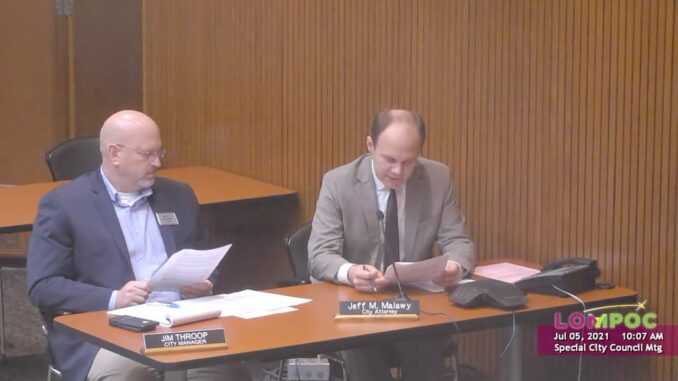
KSBY Story – “City of Lompoc Looking into Allegations against Councilmember”
Lompoc City Council Member AllegationsWatch the Video Report by KSBY
For those who missed it here’s the link to the KSBY story that aired last night highlighting but a few of the general allegations that I brought against city council member Gilda Cordova, Visit Lompoc LLC, and the City of Lompoc. While the news segment was brief, the list of my allegations was not.
To date, those allegations have been submitted to the California Fair Political Practices Commission (FPPC), the Santa Barbara County Civil Grand Jury, city council, and the city attorney.
The City of Lompoc did issue a statement that “a preliminary review reveal[ed] those allegations contain several legal inaccuracies regarding the city’s contractual relationship with Visit Lompoc, Inc. and the city’s Tourism Business Improvement District program.”
More specifically the city is challenging my assertion that Visit Lompoc LLC and the city improperly raised the Tourism Business Improvement District (TBID) assessment rate from 2% to 3% in 2020.
When I challenged the city attorney to the legal arguments underlying my claim, he stated that he hasn’t had enough time to dig deep enough into it but apparently was confident enough to state that my assertions are legally inaccurate.
In any event, if I’m correct the city and Visit Lompoc LLC could be on the hook for over half a million dollars and potentially hundreds of thousands more in costs associated with returning the illegally collected funds.
In my effort to be transparent, here’s my analysis regarding the TBID assessment being raised improperly from 2% to 3% so that all can see for themselves whether or not you believe the city and Visit Lompoc LLC complied with California State law.
Below is the legal framework for what I believe was required of the city and of Visit Lompoc LLC to increase the TBID assessment rate.
Business Improvement Districts are governed under California Streets and Highways Code, Division 18 – Parking Part 7 – Property and Business Improvement District Law of 1994 (hereinafter “BID Law of 1994”.) Below is a list of the pertinent laws pertaining to adjusting a TBID assessment rate:
- BID Law of 1994, Section 36629, “…the city council shall, to establish, modify, or disestablish a benefit zone or category of business, follow the procedure to establish, modify, or disestablish a property and business improvement district.”
- BID Law of 1994, Section 36635, “The owner’s association may, at any time, request that the city council modify the management district plan. Any modification of the management district plan shall be made pursuant to this chapter.”
- BID Law of 1994, Section 36636, “(a) Upon the written request of the owners’ association, the city council may modify the management district plan after conducting one public hearing on the proposed modifications. The city council may modify the improvements and activities to be funded with the revenue derived from the levy of the assessments by adopting a resolution determining to make the modifications after holding a public hearing on the proposed modifications. If the modification includes the levy of a new or increased assessment, the city council shall comply with Section 36623. Notice of all other public hearings pursuant to this section shall comply with both of the following: (1) The resolution of intention shall be published in a newspaper of general circulation in the city once at least seven days before the public hearing. (2) A complete copy of the resolution of intention shall be mailed by first class mail, at least 10 days before the public hearing, to each business owner or property owner affected by the proposed modification. (b) The city council shall adopt a resolution of intention which states the proposed modification prior to the public hearing required by this section. The public hearing shall be held not more than 90 days after the adoption of the resolution of intention.”
- BID Law of 1994, Section 36623, “(b) If a city council proposes to levy a new or increased business assessment, the notice and protest and hearing procedure shall comply with Section 54954.6 of the Government Code, except that notice shall be mailed to the owners of the businesses proposed to be assessed…”
- Government Code, Section 54954.6, “(a)(1) Before adopting any new or increased general tax or any new or increased assessment, the legislative body of a local agency shall conduct at least one public meeting at which local officials shall allow public testimony regarding the proposed new or increased general tax or new or increased assessment in addition to the noticed public hearing at which the legislative body proposes to enact or increase the general tax or assessment. For purposes of this section, the term “new or increased assessment” does not include any of the following: (D) An assessment that does not exceed an assessment formula or range of assessments previously specified in the notice given to the public pursuant to subparagraph (G) of paragraph (2) of subdivision (c) and that was previously adopted by the agency or approved by the voters in the area where the assessment is imposed.”
In the case at hand, Visit Lompoc LLC, is the owner’s association contracted by the City of Lompoc to administer the Lompoc Tourism Improvement District Management District Plan (hereafter “Management Plan”). The current contract is for a duration of ten (10) years from 2019 – 2028 and is worth an approximately $9.1 million dollars. Visit Lompoc LLC is contractually obligated to abide by the terms and conditions of the Management Plan.
In the Management Plan, page 9, Section “D. Assessment” it states, “During the ten (10) year term, the Visit Lompoc Board may request the assessment rate be increased to a maximum of five percent (5%) of gross short-term room rental revenue. The maximum assessment increase in any year shall be no more than one percent (1%) of gross short-term room rental revenue. Each request for annual increase, if any, shall be submitted by Visit Lompoc as part of its annual report and be subject to the Council’s approval as part of that annual report.”
Consistent with this requirement on August 6, 2019, Visit Lompoc’s Annual Report was presented to the Lompoc city council. In the “2019 Annual Report” Visit Lompoc on page 5, Section “Assessment” states, “On April 11, 2019, the Visit Lompoc Board approved a one percent (1%) increase to the assessment effective January 1, 2020. Subject to City Council approval of this annual report, the assessment rate shall be three percent (3%) of gross short-term room rental revenue effective January 1, 2020.”
Here, the report clearly states that the increase is “subject to city council approval.” Lompoc City Council is then obligated to follow applicable state laws regarding the request for increase of an assessment rate, specifically the BID Law of 1994 in this case. As identified above, Section 36636(a) states that the city council may modify the management district plan AFTER conducting one public hearing on the proposed modifications. It also states that the city must give proper notice of the public hearing to include posting a notice of resolution of intention in a local newspaper at least seven days before the public hearing and mailing a complete copy of the resolution of intention to each business owner affected by the proposed modification at least 10 days before the public hearing. That same section goes to state that if the modification includes an increased assessment that the city council must also follow BID Law of 1994 Section 36623.
Section 36623, as referenced above, requires that the city also comply with Government Code Section 54954.6 if there’s a request for an increase in the business assessment rate. Government Code Section 54954.6 requires that a public meeting be held in addition to the public hearing. A public meeting and public hearing are two different requirements, this particular section is dealing with a public meeting. It goes on to state under subsection (a)(1)(D) that the requirement for the additional public meeting was not required if the assessment does not exceed a “range of assessments previously specified and adopted by city council.” In this case, the Management Plan clearly lays out that Visit Lompoc LLC may request assessment increases up to 5% in 1% increments, thus the requirement for the additional public meeting did not apply.
However, the requirement for a public hearing and proper notice were still required to be followed. The city council did not pass a resolution of intention to increase the assessment rate from 2% to 3%, the city council did not publish the non-existent resolution of intention in a local newspaper, they did not mail the non-existent resolution of intention to affected business owners, and they did not hold a public hearing within 90 days of the passing of the non-existent resolution of intention.
It should also be noted that my analysis is consistent with other cities in California who have increased their BID assessment rates. For example, in 2003, the City of San Jose, owner’s association sent a letter (http://www3.sanjoseca.gov/clerk/agenda/4_22_03docs/04_22_03_2.4.htm) to their city council informing them that they were requesting an increase in their assessment rate. They informed the city council that in order to effectuate the increase that the city council would have to “adoption of a resolution of intention to levy increased assessments in the Downtown Business Improvement District…” The letter goes on to state that the city must comply with the BID Law and that a public hearing would have to be held and that the city clerk would need to publish the required notice. In this case the San Jose BID owner’s association understood what was required in order to request an increase in the assessment rate, but unfortunately for Lompoc our owner’s association Visit Lompoc LLC, our city council, and our city attorney did not (and apparently still don’t).
Because the BID Law of 1994 procedures were not complied with, the purported increase of the assessment rate from 2% to 3% was invalid and the collection of the increased rate was presumably unlawful. To make matters worse, the city is the collection agent for the TBID funds, thus the city was the agency which collected the unlawful increase in funds from the affected businesses. For 2020 and 2021 that amount totaled approximately $320,554.22 in unlawfully collected funds by the city. Because Visit Lompoc has not submitted their Annual Report accounting for 2022, it’s unclear how much was unlawfully collected in that year but it’s likely to put the total amount of unlawfully collected funds at over half a million dollars.
It’s unclear what the remedy to this is. The closest court decisions to something like this happening is when businesses charge too much sales tax and the courts have ordered them to refund customers the overcharged amount. Here that poses substantial issues in the fact that even though the city of Lompoc collected the funds, those funds were then dispersed to a private corporation as Visit Lompoc LLC. Even should the city be able to recoup those funds, the city doesn’t know who paid them as it was the hotels who charged it.
Then, even should the city refund that money back to the hotels, the manpower and accounting costs to the hotels to refund the money to those past customers would cost the hotels tens of thousands of dollars.
Which begs the question as to whether those hotels, who paid what they were told to pay by the City of Lompoc, would then have to sue the city to recoup the expenses they incur as a result of the cities negligence. Perhaps a court could reach a different resolution but, in any event,
I believe it’s clear that the City of Lompoc failed to follow established state law.
